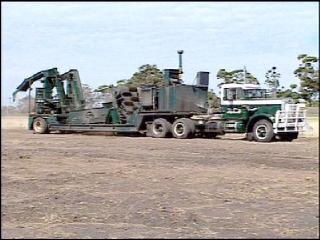|
"GREEN
LEAD" – OXYMORON OR FUTURE VISION?
Elizabeth O’Briena,
Cornelia Dostb, Bei Quc a Manager, b,c Interns,
Global Lead Advice & Support Service (GLASS)
run by The LEAD Group Incorporated
Conference Paper Presented by Elizabeth O’Brien
at the Minerals Council of Australia (MCA)
Conference on Sustainable Development in the Product Stewardship
Session:
Tue 1st Nov 2005, 11am-1pm, Alice Springs
Contents
Introduction
Leaded Petrol Ban
Batteries
E-equipment
Facts of lead poisoning worldwide
Corporate work/International action
Global Lead Advice & Support
Service (GLASS)
References
REFERENCES
- Abare (2009),
Australian Commodity Statistics. Available:
http://data.daff.gov.au/data/warehouse/pe_abarebrs99001676/acs_09.pdf
- Australian Government. Department of the Environment and
Heritage. (1989), The Hazardous Waste Act. Retrieved: 29 August 2005.
Available: www.environment.gov.au/settlements/chemicals/hazardous-waste/guide.html
- Australian Government Department of the Environment and Heritage
(2009) Tighter criteria for e-waste export. www.environment.gov.au/about/publications/annual-report/08-09/pubs/vol2-full.pdf Retrieved:
9 December 2009.
- Battery
Recycling,
LEAD-ACID BATTERY RECYCLING
RATE REMAINS STRONG More than 97 percent of all battery lead is
recycled.
Retrieved: 24 June 2009. Available: http://batterycouncil.org/?page=Battery_Recycling
- Bailey, Alycia (2003) Lead, Ageing and Death,
The LEAD
Group. Retrieved: 30 August 2005. Available: www.lead.org.au/fs/fst24.html
- BAN - Basel Action Network. (2002),
About BAN. Retrieved:
29 August 2005. Available: www.ban.org/main/about_Basel_Ban.html
- BAN - Basel Action Network, Silicon Valley Toxics Coalition
(SVTC). (2002), Exporting Harm – The High-Tech Trashing of Asia, Retrieved: 30
August 2005. Available: www.ban.org/#HighTechTrash
- BHP Billiton Ltd. (2004),
Annual report 2004. Available:
www.bhpbilliton.com/bbContentRepository/Reports/bhpb_ltd_full_04.pdf
- BHP Billiton Ltd. (2005), Community Programmes and Support
Foundation. Retrieved: 16 September 2005. Available: www.bhpbilliton.com/bb/sustainableDevelopment/community/programs/home.jsp
- Burrell,
I. (2005), E-mail contact with the LEAD Group on recycling of lead-acid batteries,
International Lead and Zinc Study Group, London.
- Canadian Environment Industry Association (CEIA). (2001),
Computer
Recycling Infrastructure in Canada, Retrieved: 5 September 2005. Available:
www.epsc.ca/pdfs/Infrastructure_Report_ENG.pdf
- Canon.
(2005), ICT Industry seeks Australian battery recycling solution. Retrieved: 2
September 2005. Available: www.canon.com.au/home/story_1352.html
- CBH
Resources Ltd. (2004), Annual report 200. Available: http://cms.cbhresources.com.au//information/pdf/Annual04.pdf
- Centers for Disease Control and Prevention. National Center for
Health Statistics. National Health and Nutrition Examination Survey. (2005),
Blood Lead
Levels-United States 1999-2002, MMWR. 54,20: 513-516. Retrieved: 31 August 2005.
Available: www.cdc.gov/mmwr/preview/mmwrhtml/mm5420a5.htm#tab1
- Centre for Design. (2005),
Mission statement. Retrieved 30
August 2005. Available: www.cfd.rmit.edu.au/
- Chinese Environment Law (2004),
It is inevitable to avoid
environment pollution in Guiyu for its electronic rubbish industry, Retrieved: 31
August 2005. Available: www.riel.whu.edu.cn/show.asp?ID=1420
- Cobbing,
M. Divecha, S. (2005). The Myth of Automobile Battery Recycling, Greenpeace.
Retrieved: 2 September 2005. Available: http://reuse-batteries-not-recycle.blogspot.com.au/
- Donovan, J. AIHW. (1996), Lead in Australian Children:
Report On The National Survey Of Lead In Children, Canberra: Australian Institute of
Health & Welfare, Lead_in_Australian_children.pdf
- Environmental Protection Agency (EPA) (2005),
Questions &
Answers on EU Policies on Electric and Electronic Waste, European Commission
Representation in Ireland. Retrieved: 8 September 2005 Available: http://www.epa.ie/enforcement/weee/electricalandelectronicequipment/
- EUROPA. (2005),
Environment – waste. Retrieved: 2
September 2005. Available: http://ec.europa.eu/environment/waste/index.htm
- Falk, H. (2003),
International Environmental Health for the
Pediatrician: Case Study of Lead Poisoning, Pediatrics. 112; 259-264. Retrieved: 30
August 2005. Available: http://pediatrics.aappublications.org/content/112/Supplement_1/259.full
- Fenton
Communications (2000) Hidden History Of Leaded Gasoline Reveals Industry Conspiracy To
Conceal Dangers - Lethal Product Still Marketed Throughout World. Media release of 20
March 2000. Retrieved 23 September 2005. Available: www.lead.org.au/lanv8n1/l8v1-3.html
- Fewtrell,
L; Kaufmann, R; and Prüss-Üstün, A (2003), Annex 4: Estimating the global disease burden of environmental lead
exposure; and Annex 5: Calculation spreadsheet for lead, EXTRACT
FROM Lead: Assessing the environmental burden of disease,
Environmental burden of disease series No. 2.World
Health Organisation (WHO), Retrieved: 30
August 2005. Available:
http://www.who.int/quantifying_ehimpacts/publications/en/9241546107ann4-5.pdf
- Freed,
J. (2005), China syndrome stokes BHP, The Sydney Morning Herald 25th
August 2005.
- George Foundation, The (1999),
Project Lead-Free Findings - A
study Of Blood Lead Levels In Approximately 22,000 samples taken in 7 major Indian Cities.
Retrieved 4 March 1999. Available: www.leadpoison.net/country/study.htm
- González, P. (2004),
Mining Royalties, International
Development Research Center Canada. Retrieved: 6 September 2005 Available:
www.idrc.ca/uploads/user-S/11129873931smds2_eng.pdf
- Greenpeace.
(2005), A Chinese child sits amongst a pile of wires and e-waste, Picture.
Retrieved: 28 August 2005. Available www.greenpeace.org/international/photosvideos/photos/a-chinese-child-sits-amongst-a
- Greenpeace.
(2005), Part of a computer with a "NYSE property tag" label at a Chinese
e-waste scrap yard, Picture. Retrieved: 28 August 2005. Available www.greenpeace.org/international/photosvideos/photos/part-of-a-computer-with-a-nys
- Ha, T. (2003),
E-waste. Retrieved: 30 August 2005.
Available: www.abc.net.au/science/features/ewaste/default.htm
- Hay, J.E. Noonan,M. (2001), Anticipating the Environmental Effects of Technology,
Overview of lead recycling, United Nations Environment Programme, Division of
Technology, Industry, and Economics. Retrieved: 14 September 2005. Available:
www.unep.or.jp/ietc/Publications/Integrative/EnTA/AEET/Annex2_3.asp
- Hurley,
P. (2005a), Recycling of lead-acid batteries, e-mail by Dr. P. Hurley to the
LeadWorkers e-group, moderated by The LEAD Group, Sydney, Australia, July 27, 2005.
- Hurley,
P. (2005b), I am trying to find out about the logistics of battery recycling,
e-mail by Dr. P. Hurley to the LeadWorkers e-group, moderated by The LEAD Group, Sydney,
Australia, July 18, 2005.
- Imperial College Consultants Ltd (2001),
"LEAD: the
facts", Lead Development Association International. Retrieved: 5 September 2005.
Available: http://www.ldaint.org/lead-facts
- International
Council on Mining and Metals ICMM's environmental stewardship work
program. Retrieved: 25 June 2009 Available: http://www.icmm.com/annual-review-2009
- Kagara Zinc Ltd. (2004), Annual report 2004.
Available: www.kagara.com.au/?page=investor§ion=2&subsection=3
- Lalor, G. Rattray, R. Vutchkova, M. Campbell, B. Lewis-Bell,
C. (2001), Blood lead levels in Jamaican school children, The Science of The Total
Environment 269: 171-181 Abstract: http://www.ncbi.nlm.nih.gov/pubmed/11305338
- Lustberg, M. Silbergeld, E. (2002),
Blood lead levels and
mortality, Arch Intern Med. 2002 Nov 25;162(21):2443-9. Retrieved: 2 January 2003.
Available:
http://archinte.jamanetwork.com/article.aspx?articleid=214370
- Mathee, A. von Schirnding, Y. E. R. Levina, J. Ismail, A.
Huntley, R. Cantrell, A. (2002), A survey of blood lead levels among young Johannesburg
school children, Environmental Research Volume 90, Issue 3: November
2002, Pages 181–184. Abstract: http://www.sciencedirect.com/science/article/pii/S0013935102000105
- Midgley Jr, Thomas, (undated, probably 1926 or earlier)
Lots
of Living, From the Periodic Table to Production: The Life of Thomas
Midgley, Jr
– The Inventor of Ethyl Gasoline and Freon Refrigerants by Thomas Midgley IV,
Stargazer Publishing Company, Corona California, 2001.
- NRC – National Research Council: Committee on measuring
lead in critical populations (1993), Measuring lead exposure in infants, children and
other sensitive populations, National Academy Press Washington D.C.
- Perilya Ltd. (2004),
Annual report 2004. Available: http://www.perilya.com.au/articles/040825-2004-annual-report.pdf
- Phillips, Lauren (2005) Cartoon: The early death of Thomas
Midgley – inventor of lead additive for petrol, Sydney, 23rd September
2005.
- Puckett, J. (2003),
Recycling: no excuse for global
environmental injustice, The Basel Action Network (BAN). Retrieved: 30 August 2005.
Available: http://ban.org/library/whyban.pdf
- Rio Tinto (2003), Product Stewardship. Retrieved: 9 September
2005. Available: http://www.riotinto.com/sustainabledevelopment2012/governance/product_stewardship.html
- Roche,
M. Toyne, P. (2003), "Green Lead" a new approach to product
stewardship,
14th
International Lead Conference, Frankfurt: 21-22 October 2003, Retrieved:
14 April 2009.
- Rosselson, Leon (1981),
"Who reaps the profit? Who pays
the price?" on the specially recorded protest album "Nuclear power no
thanks!!" recorded at Gateway Studios, London, 1981. Available:
www.informatik.uni-hamburg.de/~zierke/martin.carthy/records/nuclearpowernothanks.html
- Sharp. (2004),
Creating super green products. Retrieved: 2
September 2005. Available: http://sharp-world.com/corporate/eco/report/2004pdf/37_40.pdf
- SmithBucklin Corporation, Market Research and Statistics Group.
(2005), National Recycling Rate Study. Chicago, Battery Council International.
Retrieved: 30 August 2005. Available: www.batterycouncil.org/
- Thorpe,
B. Kruszewska, I. (1999), Strategies to promote clean production extended producer
responsibility, Northern Alliance for Sustainability [ANPED], Based on a 1995 EPR
Briefing by Iza Kruszewska / Beverley Thorpe published by Greenpeace International.
Retrieved: 12 September 2005 Available: www.anped.org/media.php?id=19
- United Nation Environmental Programme
(UNEP) (2002),
New Basel
guidelines to improve recycling of old batteries, UNEP News Release 22/05/2002/40.
Retrieved: 31 August 2005 Available: www.unep.org/Documents.Multilingual/Default.asp?DocumentID=248&ArticleID=3069&l=en
- United Nations Environment Programme (UNEP) (2005a),
E-waste,
the hidden side of IT equipment manufacture and use. Retrieved: 2 September
2005 Available: www.grid.unep.ch/product/publication/download/ew_ewaste.en.pdf
- United Nations Environment Programme
(UNEP), Production and
Consumption Branch (2005), Cleaner Production Declaration – Signatory List updated
to January 2005. Retrieved: 13 September 2005 Available: www.uneptie.org/pc/cp/declaration/pdfs/updated%20siglist-Jan05.pdf
- Wang Sun-qin, Zhang Jin-liang. (2004), Blood Lead Levels of
Children in China, Journal of Environment Health 21,6: 355-360
- World Health Organization (WHO) (2004),
Children's
intellectual potential at risk European ministers finalize the Budapest Conference agenda,
Regional Office Europe. Retrieved: 1 September 2005 Available: www.euro.who.int/eprise/main/WHO/MediaCentre/PR/2004/20040401_4
- Xstrata (2004),
Annual Report 2004 Available: www.xstrata.com/reports/
doc/xta-ar2004_en.pdf
- Zinifex Ltd. (2004),
Annual report 2004 Available:
www.zinifex.com/UploadZinifexPublic/Document/ZFX%20Annual%20Report%202004.pdf
Contents
Introduction
Leaded Petrol Ban
Batteries
E-equipment
Facts of lead poisoning worldwide
Corporate work/International action
Global Lead Advice & Support
Service (GLASS)
References
|



